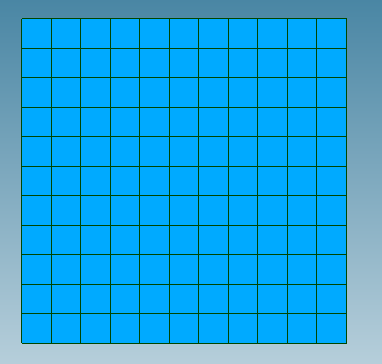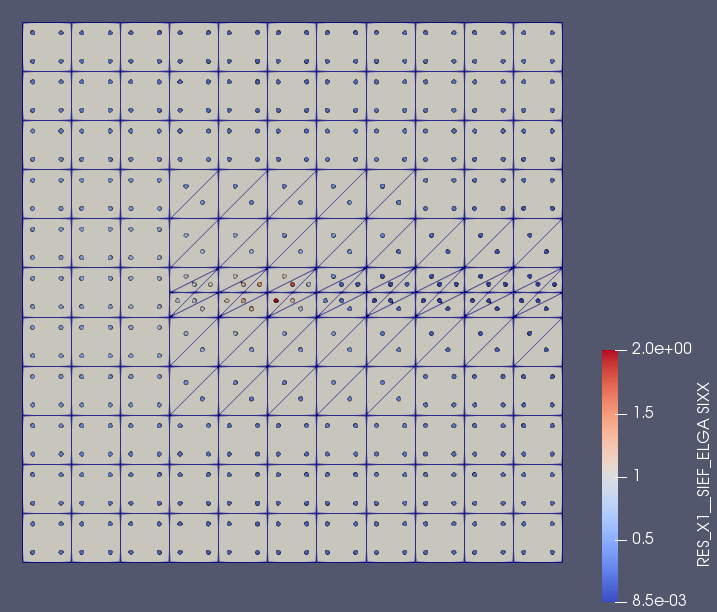3. Modeling A#
3.1. Characteristics of modeling#
We use C_ PLAN modeling.
3.2. Characteristics of the mesh#
The mesh contains 121 elements of type QUAD4.

3.3. Tested sizes and results#
The maximum and minimum stresses on the plate are tested for field SIEF_ELNO:
Identification |
Reference type |
\(\mathit{MAX}\) - \(\mathit{SIXX}\) |
“NON_REGRESSION” |
\(\mathit{MIN}\) - \(\mathit{SIXX}\) |
“NON_REGRESSION” |
\(\mathit{MAX}\) - \(\mathit{SIXY}\) |
“NON_REGRESSION” |
\(\mathit{MIN}\) - \(\mathit{SIXY}\) |
“NON_REGRESSION” |
The maximum and minimum stresses on the plate are tested for field SIGM_ELNO calculated underground by the operator CALC_ERREUR:
Identification |
Reference type |
\(\mathit{MAX}\) - \(\mathit{SIXX}\) |
“NON_REGRESSION” |
\(\mathit{MIN}\) - \(\mathit{SIXX}\) |
“NON_REGRESSION” |
\(\mathit{MAX}\) - \(\mathit{SIXY}\) |
“NON_REGRESSION” |
\(\mathit{MIN}\) - \(\mathit{SIXY}\) |
“NON_REGRESSION” |
We test the minimum and maximum constraints on the field plate SISE_ELNO (node of the sub-elements X- FEM) calculated underground by the operator CALC_ERREUR:
Identification |
Reference type |
Reference value |
Precision |
\(\mathit{MAX}\) - \(X4\) |
“NON_REGRESSION” |
0.812078942873 MPa |
1E -04% |
\(\mathit{MIN}\) - \(X4\) |
“NON_REGRESSION” |
-0.510118026455 MPa |
1E -04% |
Finally we test the field for error estimator ERME_ELEM:
Identification |
Reference type |
Reference value |
Precision |
\(\mathit{MAX}\) - \(\mathit{ERREST}\) |
“NON_REGRESSION” |
0.000698457464821 |
1E -04% |
\(\mathit{MIN}\) - \(\mathit{ERREST}\) |
“NON_REGRESSION” |
3.49704197058E-06 |
1E -04% |
3.4. notes#
The constraints obtained calculated at the nodes of the mesh by CALC_ERREUR and by CALC_CHAMP are indeed the same.
The stress field is resolved at Gauss points:

The smoothing done by calculating the stresses at the nodes introduces errors that cause the CALC_ERREURàsous -operator to estimate the error of the asymptotic field at the bottom of the crack.